Written by Benjamin Kurata
*This is the second entry in a 2-part series on Long Gun Function Testing. The first entry was published two weeks earlier.
In a previous article, I covered function testing the AR-15 / M4 patrol rifle and variants. Now, let’s turn to that old standby of the police arsenal, the 12 gauge pump shotgun. It’s a common misconception that the 12 gauge pump shotgun is maintenance free. Certainly, the majority of shotguns I’ve seen were evidence of this misguided belief. The police shotgun has to be routinely cleaned, lubricated and function tested the same as any other duty weapon. One area that most shooters overlook when cleaning and lubricating the police shotgun is the magazine tube. The tube is made of steel, and the magazine spring and shell follower are made of steel. (If the shell follower in your shotgun is a thin plastic cap, discard it and get the steel one. If the plastic cap breaks inside the magazine tube, you’ll have to put the shotgun on to the workbench to get it to work again.) When the shotgun is carried in “cruiser carry” mode, the magazine spring is compressed against the interior of the magazine tube. Let some moisture get into the magazine tube, and corrosion of magazine spring can occur.
Whenever I disassemble, clean, lubricate and function test my shotgun, I push a bore brush and patches wet with solvent through the magazine tube until the patches come out clean. I finish up with a clean patch moistened with lubricant followed by a clean, dry patch. A wipe down of the magazine spring with some lubricant completes the maintenance on the magazine tube.
Function Testing of the Pump Shotgun:
- Make certain that there is no live ammunition in the magazine tube or chamber. With the bolt back, a quick physical check through the loading port by touching the magazine follower and the empty chamber gets the task done.
- Pump the fore end all the way forward. Try to pull the fore end back. The fore end and bolt should remain locked forward.
- Put the safety on “Safe”. Press the trigger, hard. Nothing should happen.
- Point the muzzle in a safe direction and press the trigger. You should feel / hear a normal hammer fall. Keep the trigger depressed.
- With the trigger depressed, roll the shotgun sideways so you can look through the ejection port. Slowly work the fore end all the way back and then forward. You should see the shell lifter rise up when you start the fore end forward. Continue to push the fore end all the way forward while keeping the trigger depressed.
- Slowly let the trigger forward until you feel and hear the disconnector reset. It won’t take much forward motion of the trigger, and the reset will be subtle. The reset on my personal Remington 870 feels about the same as my 1911A1 Colt. Yes, all modern pump shotguns since the model 1897 Winchester have disconnectors.
- Press the trigger again. You function test is now complete.
Function Testing the Police Semiautomatic Shotgun:
- Make certain that there is no live ammunition in the magazine tube or chamber. With the bolt back, a quick physical check through the loading port or the ejection port by touching the magazine follower and the empty chamber gets the task done.
- Let the bolt go forward by pressing the bolt release button. The bolt should move forward sharply and lock into the rear of the barrel.
- Point the muzzle in a safe direction and put the safety on “Safe”. Press the trigger, hard. Nothing should happen.
- Point the muzzle in a safe direction and press the trigger. You should feel / hear a normal hammer fall. Keep the trigger depressed.
- With the trigger depressed, roll the shotgun sideways so you can look through the ejection port. Slowly pull the charging handle to the rear with your non-dominant hand and ease it slowly forward. As the bolt starts forward, you should see the shell lifter rise up. Work the charging handle back and forth a few times. You shouldn’t feel any unusual binding, just slight resistance when the bolt unlocks and a slight “bump” as the bolt body passes over the hammer.
- Pull the charging handle all the way back and let it fly forward.
- Slowly let the trigger forward until you hear and feel the disconnector reset. Again, this won’t take much forward motion of the trigger and is subtle (compared to the disconnector reset on say, an AR-15).
- Press the trigger again. Your function test is now complete.







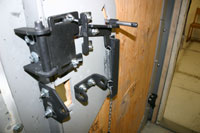 Action Target has developed a revolutionary Tactical Breaching Door™ that affords instructional staff the best option for consistent and realistic training. Our Breach Door adds a whole new dimension to training realism and eliminates the problems faced when training breaching techniques to students. The Tactical Breach Door uses advanced engineering which allows trainers to adjust the tension holding the door closed (shown below) and gives them complete control over the level of force required for a dynamic entry.
Action Target has developed a revolutionary Tactical Breaching Door™ that affords instructional staff the best option for consistent and realistic training. Our Breach Door adds a whole new dimension to training realism and eliminates the problems faced when training breaching techniques to students. The Tactical Breach Door uses advanced engineering which allows trainers to adjust the tension holding the door closed (shown below) and gives them complete control over the level of force required for a dynamic entry. The Tactical Breach Door is designed especially for use in Action Target’s Modular Armored Tactical Combat House (MATCH) shoothouse but it can also be used in a stand-alone frame or can be modified to fit into any existing shoothouse.
The Tactical Breach Door is designed especially for use in Action Target’s Modular Armored Tactical Combat House (MATCH) shoothouse but it can also be used in a stand-alone frame or can be modified to fit into any existing shoothouse.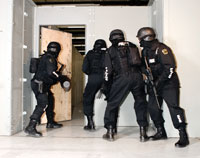 “Action Target’s Tactical Breach Door will advance training to a whole new level. For those of us who train, this innovation is a powerful and functional tool that will allow us to better prepare our teams to protect their own lives and the lives of those around them. Every law enforcement officer, special ops team and military recruit needs to be trained with this door so they can learn the techniques that will make building and room entries safer when breaching the fatal funnel.”
“Action Target’s Tactical Breach Door will advance training to a whole new level. For those of us who train, this innovation is a powerful and functional tool that will allow us to better prepare our teams to protect their own lives and the lives of those around them. Every law enforcement officer, special ops team and military recruit needs to be trained with this door so they can learn the techniques that will make building and room entries safer when breaching the fatal funnel.”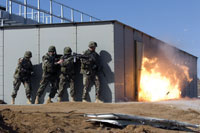 Take a look and you will see that our Tactical Breach Door will meet your training needs and can be used by itself with our free-standing option or integrate it into your MATCH or FlexTact® shoothouse.
Take a look and you will see that our Tactical Breach Door will meet your training needs and can be used by itself with our free-standing option or integrate it into your MATCH or FlexTact® shoothouse.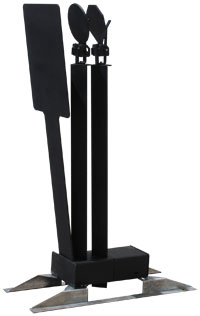 As we learn more and more about the human dynamics involved in armed confrontations, we understand that physical skills that require conscious thought or intellectual processing tend to break down rapidly under high levels of stress. If defensive skills and responses are not programmed in at a subconscious level, the sudden stress may cause us to fumble, freeze or panic. It is in this environment that reactive shooting skills are needed. Such reflexive shooting skills can be taught through the use of extremely short time limits, thus pushing the shooter to function at the limits of reaction and response time. This can be compared to learning how to hit a fast moving ball with a bat or racket, or developing the reflexes to block a punch or kick at full speed. Reactive steel targets provide the instant feedback required to program an officer’s reflexive shooting skills effectively and efficiently.
As we learn more and more about the human dynamics involved in armed confrontations, we understand that physical skills that require conscious thought or intellectual processing tend to break down rapidly under high levels of stress. If defensive skills and responses are not programmed in at a subconscious level, the sudden stress may cause us to fumble, freeze or panic. It is in this environment that reactive shooting skills are needed. Such reflexive shooting skills can be taught through the use of extremely short time limits, thus pushing the shooter to function at the limits of reaction and response time. This can be compared to learning how to hit a fast moving ball with a bat or racket, or developing the reflexes to block a punch or kick at full speed. Reactive steel targets provide the instant feedback required to program an officer’s reflexive shooting skills effectively and efficiently.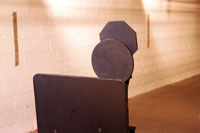 The basic function of the Bobber X-treme™ will probably sound familiar. A steel plate is presented to the shooter from behind cover. This plate can be hit at any time while it is exposed, and a computer interface is used to control the frequency and duration of the target exposures.
The basic function of the Bobber X-treme™ will probably sound familiar. A steel plate is presented to the shooter from behind cover. This plate can be hit at any time while it is exposed, and a computer interface is used to control the frequency and duration of the target exposures.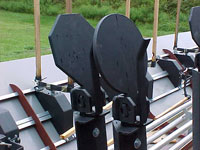 Judgment – Split-second judgment and threat analysis may be the most important elements of the training triangle. The revolutionary Bobber X-treme™ addresses this issue by presenting the shooter with two separate target plates, one directly behind the other. One plate is an 8-inch circle, and the other is an 8-inch octagon. Depending on your training scenario, you can classify all the circle plates as hostile, and all the octagon plates as friendly. When one of the plates jumps up from behind cover, the shooter must quickly determine whether the plate is hostile or friendly and then take the appropriate action. The circles and octagons look enough alike to force the shooter to be sure.
Judgment – Split-second judgment and threat analysis may be the most important elements of the training triangle. The revolutionary Bobber X-treme™ addresses this issue by presenting the shooter with two separate target plates, one directly behind the other. One plate is an 8-inch circle, and the other is an 8-inch octagon. Depending on your training scenario, you can classify all the circle plates as hostile, and all the octagon plates as friendly. When one of the plates jumps up from behind cover, the shooter must quickly determine whether the plate is hostile or friendly and then take the appropriate action. The circles and octagons look enough alike to force the shooter to be sure.